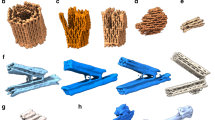Abstract
DNA machines consisting of consecutive hairpins, which we have previously described, have various potential applications in DNA computation. In the present study, a 288-base DNA machine containing four consecutive hairpins was successfully constructed by ligation and PCR. PAGE and fluorescence spectroscopy experiments verified that all four hairpins were successfully opened by four opener oligomers, and that hairpin opening was dependent on the proper openers added in the correct order. Quantitative analysis of the final results by fluorescence spectroscopy indicated that all four hairpins were open in about 1/4 to 1/3 of the DNA machines.








Similar content being viewed by others
References
Dirks RM, Pierce NA (2004) Triggered amplification by hybridization chain reaction. Proc Natl Acad Sci 101(43):15275–15278
Hagiya M, Yaegashi S, Takahashi K (2005) Computing with Hairpins and Secondary Structures of DNA. In: Nanotechnology: science and computation, Natural computing series. Springer, pp 293–308
Kameda A, Yamamoto M, Uejima H, Hagiya M, Sakamoto K, Ohuchi A (2005) Hairpin-based state machine and conformational addressing: design and experiment. Nat Comput 4(2):103–126
Rothemund PWK (2006) Folding DNA to create nanoscale shapes and patterns. Nature 440:297–302
Seelig G, Yurke B, Winfree E (2005) DNA Hybridization catalysts and catalyst circuits. In: DNA computing, 10th international workshop on DNA computing. Lecture Notes in Computer Science, vol 3384, pp 329–343
Takahashi K, Yaegashi S, Kameda A, Hagiya M (2006) Chain reaction systems based on loop dissociation of DNA. In: DNA computing: 11th international workshop on DNA computing, DNA11. Lecture Notes in Computer Science, vol 3892, pp 347–358
Takahashi N, Kameda A, Yamamoto M, Ohuchi A (2005) Aqueous computing with DNA hairpin-based RAM. In: DNA computing, 10th international workshop on DNA computing. Lecture Notes in Computer Science, vol 3384, pp 355–364
Uejima H, Hagiya M (2004) Secondary structure design of multi-state DNA machines based on sequential structure transitions. In: DNA computing, 9th international workshop on DNA-based computers. Lecture Notes in Computer Science. Springer, vol 2943, pp 74–85
Yan H (2005) An inexpensive LED-based fluorometer used to study a hairpin-based DNA nanomachine. In: DNA computing, 10th international workshop on DNA computing. Lecture Notes in Computer Science, vol 3384, pp 399–409
Yurke B, Turberfield AJ, Mills Jr AP, Simmel FC, Neumann JL (2000) A DNA-fuelled molecular machine made of DNA. Nature 406:605–608
Acknowledgement
The work presented in this paper was partially supported by Grand-in-Aid for Scientific Research on Priority Area No. 14085202, Ministry of Education, Culture, Sports, Science and Technology, Japan.
Author information
Authors and Affiliations
Corresponding author
Rights and permissions
About this article
Cite this article
Kameda, A., Yamamoto, M., Ohuchi, A. et al. Unravel four hairpins!. Nat Comput 7, 287–298 (2008). https://doi.org/10.1007/s11047-007-9035-y
Received:
Accepted:
Published:
Issue Date:
DOI: https://doi.org/10.1007/s11047-007-9035-y




